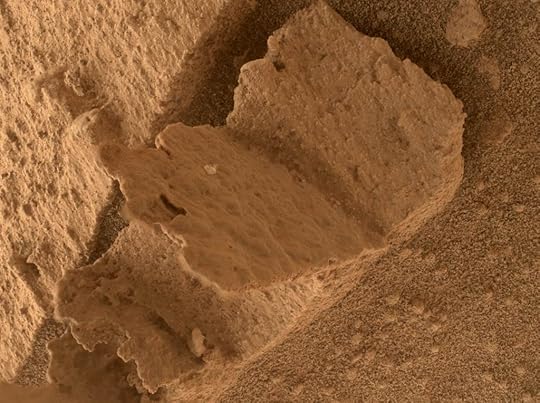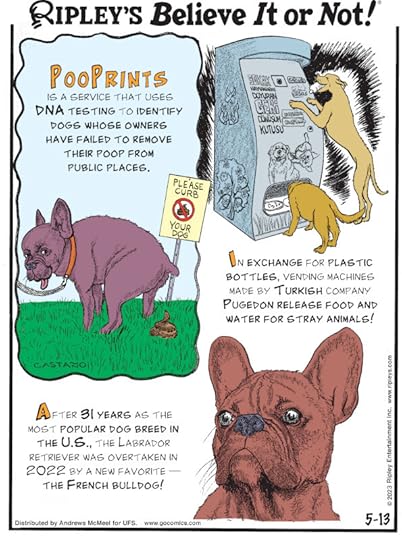Ripley Entertainment Inc.'s Blog, page 27
May 16, 2023
NASA’s Curiosity Rover Captures Bizarre “Martian Book” Pic
Featured in Ripley's Believe It or Not!

The Young Astronomer (1831), an astronomy textbook, included a curious comparison: “To the people who live on Mars, this earth probably appears larger than Mars does to us.” While the thought of people on Mars sounds crazy today, 19th-century folks saw things differently. Many believed in a “plurality of inhabited worlds.” Meaning the other planets in our solar system teemed with life.
What made people think life existed on other planets? Misconstruing telescope sightings of inexplicable forms as “unnatural” and “artificially constructed.” Although you’d be harder-pressed to find people who believe in Martians today, the eye tricks haven’t stopped. Check out the recent discovery of a “fossilized book” on Mars to see what we mean.
Weird Things Seen on MarsTo say that the landscapes of Mars have played tricks with people’s eyes is an understatement. What’s more, these mind-bending images have forced people to get really creative. One of the most famous examples of seeing something in nothing is the so-called “Face on Mars” taken in 1976 by NASA’s Viking 1 Orbiter spacecraft.

Credit: NASA/JPL-Caltech/UArizona.
After developing the photos, scientists found a humanoid face staring back at them. Closer analysis revealed the strange visage to be nothing more than a rocky surface where shadows and light played, creating strangely anthropomorphic features. Soon, tabloids splattered the “Face on Mars” across their front pages, and the scientific explanation for the phenomenon got buried in sensationalism.
For those who’ve heard of pareidolia, you understand that the human eye naturally corrects random shapes, infusing them with patterns, meaning, and order. Even where these characteristics don’t exist. Pareidolia accounts for many sensational images spotted on Mars over the years. These include a floating spoon, a side profile of an elephant, the Star Trek logo, and one of the most adorable bear faces we’ve seen since the Hundred Acre Woods. So, it shouldn’t be surprising that people have now discovered a fossilized book on Mars.
The Case of the Fossilized Martian BookImages from NASA’s Curiosity rover boast an incredible amount of detail. Some might argue a little too much. After pictures of what looks like a stone book turned up, people got excited. And with good reason. After all, the photo appears to show a fossilized book mid-page turn. But context is everything. As it turns out, the Martian book measured little more than one inch! In other words, if the book represents a proof of life, then Mars is inhabited by tiny critters that would make the dolls at Disney’s “Small World” ride look like behemoths.

Credit: NASA/JPL-Caltech/MSSS.
What else do we know about the photo? It turned up in images snapped on April 15th using the Mars Hand Lens Imager (MAHL) attached to a robotic arm. Although the book-like structure has intrigued internet users, the shape of the rock isn’t really that surprising. A NASA representative explains, “Rocks with unusual shapes are common on Mars.
What lends them their weird appearance? Their composition. Many rocks on the Red Planet come from minerals deposited when Mars housed ancient waterways. Over time, these minerals got buried in layers of softer sediment. Fast forward billions of years, and wind erosion stripped the softer sediments from these mineral deposits, creating strange geology. So, while we’d like to think the fossilized book came directly from John Carter’s Martian library, geology offers a more reasonable explanation.
By Engrd Barnett, contributor for Ripleys.com
EXPLORE THE ODD IN PERSON! Discover hundreds of strange and unusual artifacts and get hands-on with unbelievable interactives when you visit a Ripley’s Odditorium!Source: NASA’s Curiosity Rover Captures Bizarre “Martian Book” Pic
CARTOON 05-16-2023
May 15, 2023
CARTOON 05-15-2023
May 14, 2023
CARTOON 05-14-2023
May 13, 2023
CARTOON 05-13-2023
May 12, 2023
Up Close & Peculiar: Contraptions Used For Casino Cheating
Featured in Ripley's Believe It or Not!

Today: Casino Cheating
Are you feeling lucky? You might not be after you take a look at these rigged gabling devices on this episode of Up Close & Peculiar!
Today we are here at the Ripley’s Warehouse with some mysterious contraptions. Now, I am a Vegas girlie, I’ve been frequenting the strip since I was just a tiny tot, and I can tell you right now if I was seen anywhere near a casino with any of these I would get kicked out in ten seconds! Let’s take a look at what we have here.
Starting off with a box of dice that belonged to mobster Rafael Aiello. Now, some of these dice only have two or three numbers on them and that is because these were used for, you guessed it, scamming!
Between the 1940’s and 1960’s, Aiello started to run illegal dice games across Chicago where he would use sleight of hand to swap out the legitimate dice for rigged ones. Apparently, Aiello got so good at defrauding these people that Al Capone personally asked him to start working for him… or else!
Moving on, I have a couple other examples, including a mirrored card dealing shoe, where it shows the dealer the cards as they’re being dealt. This one is pretty modern, it’s from the 1970’s!
We also have a card trimmer that dates back to the 1800s! The card trimmer was used to ever so slightly mark cards so when the dealer was handling their cards they could know exactly what ones they had in their hand. This would definitely not fly in a casino today.
Have you ever been scammed while gambling? Tell us your stories down below, and I’ll see you next time!
EXPLORE THE ODD IN PERSON! Discover hundreds of strange and unusual artifacts and get hands-on with unbelievable interactives when you visit a Ripley’s Odditorium!Source: Up Close & Peculiar: Contraptions Used For Casino Cheating
In A First, Astronomers Spot A Star Swallowing A Planet
Featured in Ripley's Believe It or Not!

For the first time ever, astronomers were able to see a planet being consumed by a dying star. Up until this point, scientists have only observed the moments before and after a star engulfs a planet.
The Milky Way MiracleWhen stars run out of fuel, they grow exponentially and swallow all the matter in their vicinity, including planets, according to a press release from MIT. New research on the planet-engulfing-star was published in Nature by a team from MIT, Harvard University, and Caltech.
“For decades, we’ve been able to see the before and after,” explained lead author Kishalay De, a postdoc in MIT’s Kavli Institute for Astrophysics and Space Research. “Before, when the planets are still orbiting very close to their star, and after, when a planet has already been engulfed, and the star is giant. What we were missing was catching the star in the act, where you have a planet undergoing this fate in real-time. That’s what makes this discovery really exciting.”
The incident seems to have occurred in the Milky Way galaxy approximately 12,000 light-years away near the Aquila constellation. Over the course of 10 days, scientists watched a star get 100 times brighter than usual and then disappear. The white-hot flash preceded a cold, long-lasting signal. Researchers believe the event was a star overtaking a nearby planet.
For the first time, scientists have caught a star in the act of swallowing a planet — not just a nibble or bite, but one big gulp. It’s a preview of what will happen to Earth when our sun morphs into a red giant. https://t.co/kLOAnUCJ9H pic.twitter.com/EOyPsEuFJo
— The Associated Press (@AP) May 3, 2023
According to De, the team observed the “end-stage of the swallowing.”
Scientists believe the planet was the size of Jupiter. It spiraled close to the dying star and was pulled into its atmosphere before being consumed. In five billion years, Earth will likely be subjected to the same end when the sun burns out and swallows the Milky Way’s inner planets.
“If some other civilization was observing us from 10,000 light-years away while the sun was engulfing the Earth, they would see the sun suddenly brighten as it ejects some material, then form dust around it, before settling back” De explained.
An Outrageous OutburstThe astronomers initially noticed the planet-swallowing event in May 2020 through data from the Zwicky Transient Facility (ZTF) at Caltech’s Palomar Observatory in California. The ZTF looks for supernovae, gamma-ray bursts, and other events in the sky. Additional data was analyzed from the Keck Observatory in Hawaii, and one year later, an infrared camera from the Palomar Observatory.
“That infrared data made me fall off my chair,” De noted. “The source was insanely bright in the near-infrared.”
The star initially burned hot but then emitted colder energy over the period of a year. Using data from NASA’s infrared space telescope, NEOWISE, astronomers determined that the total energy the star released after its outburst was 1,000-times smaller than what they had previously observed.
“That means that whatever merged with the star has to be 1,000 times smaller than any other star we’ve seen,” De explained. “And it’s a happy coincidence that the mass of Jupiter is about 1/1,000 the mass of the sun. That’s when we realized: This was a planet, crashing into its star.”
Earth’s End?Will Earth’s inhabitants be able to escape before the sun swallows our planet five billion years from now? Perhaps alien assistance will be required. And by then, there is a good chance we will have made first contact with them.
Extraterrestrial life may learn about our presence in the galaxy sooner rather than later. New research from The University of Manchester and the University of Mauritius indicates that aliens may discover humans due to leaked radio signals from cell phone towers.
According to Professor Mike Garrett, Team Leader of the project and Director of Jodrell Bank Centre for Astrophysics at The University of Manchester, “Current estimates suggest we will have more than one hundred thousand satellites in low Earth orbit and beyond before the end of the decade. The Earth is already anomalously bright in the radio part of the spectrum; if the trend continues, we could become readily detectable by any advanced civilization with the right technology.”
Dr Nalini Heeralall-Issur, Saide’s supervisor and Associate Professor at the University of Mauritius, added: “I believe that there’s every chance advanced civilizations are out there, and some may be capable of observing the human-made radio leakage coming from planet Earth.”
By Noelle Talmon, contributor for Ripleys.com
EXPLORE THE ODD IN PERSON! Discover hundreds of strange and unusual artifacts and get hands-on with unbelievable interactives when you visit a Ripley’s Odditorium!Source: In A First, Astronomers Spot A Star Swallowing A Planet
CARTOON 05-12-2023
May 11, 2023
3,000-Year-Old Artifacts Discovered in Ancient Well
Featured in Ripley's Believe It or Not!

Archaeologists in Germany recently found a 3,000-year-old well near Munich with a treasure trove of items that may date back to the Bronze Age. The wishing well, which researchers believe was used for rituals, contained finely crafted ceramics, jewelry, and other objects, according to the Smithsonian. The well was discovered during an excavation in the area to prepare for the construction of a distribution center.
Well, Well, Well…Located in Germering in Bavaria, over 70 wells have been uncovered by archaeologists, according to the Bavarian State Office for Monument Protection. These wells were created from the Bronze Age to early Middle Ages and were used to supply water to the area. The wishing well in particular is unlike the other wells in that it included bronze clothing pins; ceramic bowls, cups, and pots; metal spires; amber beads; a bracelet, and other items.
The wishing well had an initial depth of 16 feet, which indicates groundwater levels had dropped and the area may have been coping with a drought. Researchers believe people may have been lowering items into the well and wishing for good fortune. Mathias Pfeil of the Bavarian State Office for Monument Protection, explained, “Even today, fountains have something magical about them for many people. They drop coins in the hope that their wishes will be granted.”
It is unclear exactly what the people’s mindset was 3,000 years ago; however, the ritual may have been “intended as sacrifices for a good harvest.”
A Well-Preserved WellThe preservation of the well and its contents for such an extended period is notable, according to archaeologist Jochen Haberstroh from the Bavarian State Office for Monument Protection. The walls of the well are still intact and partially moistened from the groundwater. The team plans on analyzing the artifacts to learn more information about the people who lived during the Bronze Age. In total, approximately 13,500 items from the area are contained at the local museum, the ZEIT+RAUM.
@historical_han_ Exciting archaeology news #archaeology #bronzeage #ancient #history #historytok #discovery #germany #learnontiktok ♬ original sound – Historical Han
Water was integral for ancient civilizations when it came to surviving and was an agricultural necessity. As a result, water sources, such as wells, were often sanctified or ritualized. People would add stones to form wells around local springs and use them for gathering places, according to Ancient Origins. These places were sacred for Germanic and Celtic civilizations, who were known to put wooden statutes representing spiritual guards alongside them. They also made “sacrificial offerings” by burying the armor of their enemies into bogs and other water sources.
European folklore mentions wishing wells in which people would toss gold coins into them to achieve their desires. Even today, the centers of many European towns contain fountains that residents and visitors fill with coins. The theory is that it is good luck to throw a coin into a well or fountain. However, many archaeologists theorize that ancient people accidentally discovered the benefits of copper and silver, which can kill or prevent the growth of microorganisms. Throwing coins into a well would, in turn, make it safer to drink the water (which is good fortune).
By Noelle Talmon, contributor for Ripleys.com
EXPLORE THE ODD IN PERSON! Discover hundreds of strange and unusual artifacts and get hands-on with unbelievable interactives when you visit a Ripley’s Odditorium!CARTOON 05-11-2023
Ripley Entertainment Inc.'s Blog
- Ripley Entertainment Inc.'s profile
- 52 followers










